Maps and Plans
1890 map issued by the Western Highlands and Island Commission
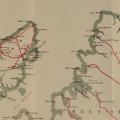 This map shows the location and route of all the main railways proposed to the Western Highlands and Islands Commission during their inquiry in 1890.
This map shows the location and route of all the main railways proposed to the Western Highlands and Islands Commission during their inquiry in 1890.
The railway routes marked out on Skye and Lewis were later revised - in the case of Lewis, to a far simpler proposal, and in the case of Skye, to a far longer route.
Note the position of the village of Ullapool on this map - several miles south-east of where it should be!
This image supplied courtesy of the National Records of Scotland.
Frontispiece of the Plans and Sections document for the Garve to Ullapool Railway (1890)
 This document contains all the plans (i.e. of the railway seen from above) and sections (i.e. of the railway seen from the side, against the contours of the ground) of the proposed route of the Garve to Ullapool railway.
This document contains all the plans (i.e. of the railway seen from above) and sections (i.e. of the railway seen from the side, against the contours of the ground) of the proposed route of the Garve to Ullapool railway.
A few of the individual pages of this document are available below.
These plans were prepared by the Highland Railway Company engineers Murdoch Paterson (see him below) and C.R. Manners.
This image supplied courtesy of the National Records of Scotland.
Ordnance Survey map for the Garve to Ullapool Railway
 Most of the plans for proposed railways included a 1-inch Ordnance Survey map, with the proposed route marked in red. Shown here is the OS map which was annotated by Murdoch Paterson, for the Garve to Ullapool plans.
Most of the plans for proposed railways included a 1-inch Ordnance Survey map, with the proposed route marked in red. Shown here is the OS map which was annotated by Murdoch Paterson, for the Garve to Ullapool plans.
Some of the red ink has faded over time, but the route from Garve all the way to Ullapool is clearly shown - as is the interesting curving tunnel at Braemore!
This image supplied courtesy of the National Records of Scotland.
Plan showing Ullapool Railway junction at Garve
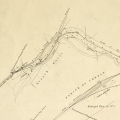 In Paterson's plans, we have here the plan and section for the junction at Garve, where the Ullapool railway was to branch off from the Dingwall to Strome Ferry line.
In Paterson's plans, we have here the plan and section for the junction at Garve, where the Ullapool railway was to branch off from the Dingwall to Strome Ferry line.
This was one of the easier sections of the proposed route.
At Garve station, the 'up' and 'down' railway tracks are set quite far apart; this was to allow for the transportation of fishing boats on special wagons, between east and west coasts. This bold plan never reached fruition...
This image supplied courtesy of the National Records of Scotland.
Plan showing Ullapool Railway at Inverbroom
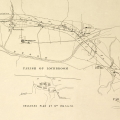 And here, on Paterson's plans, how the railway would cross the River Broom at the head of the loch, past Achlunachan, Inverbroom and then Inverlael.
And here, on Paterson's plans, how the railway would cross the River Broom at the head of the loch, past Achlunachan, Inverbroom and then Inverlael.
Inverbroom was the house in which Arthur Fowler (see below) was resident, leasing it from his father.
This image supplied courtesy of the National Records of Scotland.
Plan showing Ullapool Railway at Ardcharnich and Leckmelm
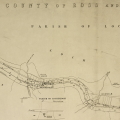 Adjacent to (further towards Ullapool) the preceding segment of the plans, how the railway skirted along the east coast of Loch Broom, past Ardcharnich and Leckmelm.
Adjacent to (further towards Ullapool) the preceding segment of the plans, how the railway skirted along the east coast of Loch Broom, past Ardcharnich and Leckmelm.
Note some of the deeper gullies to be crossed, in the lower 'section' of the image.
The Leckmelm estate had been bought in the late 1870s by the Aberdeen mill-owner, Alexander Pirie, whose first action was to evict many of his tenants. It was an action which made newspaper headlines of the day.
This image supplied courtesy of the National Records of Scotland.
Frontispiece of the plans and sections of the Aultbea Railway (1893)
 Like the one for Ullapool (above) this document contains all the plans and sections of the proposed route of the Achnasheen to Aultbea railway. This railway was more formally known as the 'Loch Maree and Aultbea Railway'.
Like the one for Ullapool (above) this document contains all the plans and sections of the proposed route of the Achnasheen to Aultbea railway. This railway was more formally known as the 'Loch Maree and Aultbea Railway'.
A few of the individual pages of this document are available below.
These plans were prepared by the famed railway engineers, Meiks of Edinburgh, whose other designs included the new hydro-electric works at Kinlochleven.
This image supplied courtesy of the National Records of Scotland.
Part of Ordnance Survey map for the Achnasheen to Aultbea Railway
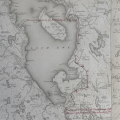 Most of the plans for proposed railways included a 1-inch Ordnance Survey map, with the proposed route marked in red. Shown here is a segment of the one prepared by the Meiks for the Aultbea railway.
Most of the plans for proposed railways included a 1-inch Ordnance Survey map, with the proposed route marked in red. Shown here is a segment of the one prepared by the Meiks for the Aultbea railway.
The village of Gairloch is carefully by-passed by the railway, and its route takes it past - possibly even through - the grounds of the Poolewe estate now managed by the National Trust for Scotland.
This image supplied courtesy of the National Records of Scotland.
Plan showing Achnasheen junction for the railway to Aultbea (1893)
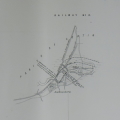 The Meik brothers prepared the Plans & Sections for the proposed Achnasheen to Aultbea railway. Shown here is the first of the plans, marking out how the railway would branch off the Dingwall to Strome Ferry line at Achnasheen, and head up Glen Docherty.
The Meik brothers prepared the Plans & Sections for the proposed Achnasheen to Aultbea railway. Shown here is the first of the plans, marking out how the railway would branch off the Dingwall to Strome Ferry line at Achnasheen, and head up Glen Docherty.
Note how the line curves around the back of Loch a'Chroisg (the opposite side from the present road to Kinlochewe) and then snakes up into the pass.
This image supplied courtesy of the National Records of Scotland.
Plan showing Achnasheen to Aultbea railway at Poolewe
 Further on, the railway to Aultbea would scrape around the south-west end of Loch Maree, head through Poolewe and head up towards Aultbea.
Further on, the railway to Aultbea would scrape around the south-west end of Loch Maree, head through Poolewe and head up towards Aultbea.
The route for the railway specifically did not go through Gairloch, slightly further south, on the grounds of cost.
The railway was planned to cross a rather terrifying bluff of hill just east of Tollie Bay, where two tunnels were proposed. (zsee also the next 'section' immediately below.)
This image supplied courtesy of the National Records of Scotland.
Section showing Achnasheen to Aultbea railway at Tollie Bay
 The decision not to pass through Gairloch, but instead to skirt the south shore of Loch Maree, led to some interesting engineering work just east of Tollie Bay, where two tunnels and some kind of viaduct would be required to bring the railway safely westwards.
The decision not to pass through Gairloch, but instead to skirt the south shore of Loch Maree, led to some interesting engineering work just east of Tollie Bay, where two tunnels and some kind of viaduct would be required to bring the railway safely westwards.
The two tunnels can be seen on this 'section' from the Meiks' designs - two jagged peaks and troughs, bottom left.
The promoters criticised the Ullapool railway plan for its single tunnel at Braemore; but saw no problem with two even more hair-raising tunnels on their own plans...
This image supplied courtesy of the National Records of Scotland.
Map of proposed railways, 1892
 After a Liberal government had been elected in the late summer of 1892, an Under-Secretary from the Scottish Office was sent out to cover the same ground as two previous official enquiries. His report and map were models of accuracy.
After a Liberal government had been elected in the late summer of 1892, an Under-Secretary from the Scottish Office was sent out to cover the same ground as two previous official enquiries. His report and map were models of accuracy.
The Under-Secretary in question was William Cosgrove Dunbar, who later became Registrar-General for England and Wales
Shown on the map are all the railways which Dunbar thought were viable - with the curious exception of the extension of the Strome Ferry line as far as Kyle of Lochalsh...
This image supplied courtesy of the National Records of Scotland.
People and Places
Sketch of the Napier Commission in 1883
 The Napier Commission is sketched here in session in October 1883. The venue was the Justice’s Court-house in the County Buildings, Glasgow.
The Napier Commission is sketched here in session in October 1883. The venue was the Justice’s Court-house in the County Buildings, Glasgow.
The artist was Alexander Stuart Boyd, aka ‘Twym’.
The panel, from left to right: Alexander Nicolson, Sir Kenneth Mackenzie, Lord Francis Napier, Malcolm MacNeill, Cameron of Locheil, Charles Fraser-Mackintosh, Donald Mackinnon.
A crowd of witnesses (or merely listeners) is shown in the foreground. In this audience, it is possible that the gentleman sitting in Highland dress on the right was John Murdoch, land-refomer and a man who spent two full days explaining life to the Napier Commission
This image was first published in Glasgow's Quiz magazine, 26 October 1883.
Sir John Fowler
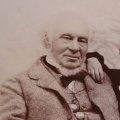 Sir John Fowler, famed railway engineer - one of his greatest achievements was co-designing the Forth Bridge - had bought the Braemore estate, at the head of Loch Broom. He acted as 'consultant engineer' for the 1890 Ullapool railway proposal.
Sir John Fowler, famed railway engineer - one of his greatest achievements was co-designing the Forth Bridge - had bought the Braemore estate, at the head of Loch Broom. He acted as 'consultant engineer' for the 1890 Ullapool railway proposal.
He is depicted here (ca. 1895) with admirable 'neck-beard' and his grandson Alan - who died in Flanders in 1915.
This image courtesy of Peter Newling of Lochside.
Arthur Fowler
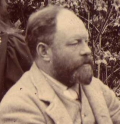 John Arthur Fowler - better known as Arthur - was the eldest son of John Fowler, and lived for much of the year on the Braemore estate. He was central to the promotion of the Ullapool railway scheme in 1890 and 1896.
John Arthur Fowler - better known as Arthur - was the eldest son of John Fowler, and lived for much of the year on the Braemore estate. He was central to the promotion of the Ullapool railway scheme in 1890 and 1896.
He is seen in this photograph, around 1892, relaxing at Inverbroom with three of his children.
This image courtesy of Peter Newling of Lochside.
Murdoch Paterson (ca. 1896)
 The railway engineer Murdoch Paterson was employed for many years (1874-1898) by the Highland Railway Company as their chief engineer. In 1890, the promoters of the Garve and Ullapool Railway asked for Murdoch to conduct a proper survey of the proposed line. Some of the plans he produced are available to view above.
The railway engineer Murdoch Paterson was employed for many years (1874-1898) by the Highland Railway Company as their chief engineer. In 1890, the promoters of the Garve and Ullapool Railway asked for Murdoch to conduct a proper survey of the proposed line. Some of the plans he produced are available to view above.
Murdoch designed many of the stations and bridges for the Highland Railway (a list of some of these may be seen here)
This image supplied courtesy of the Highland Railway Society.
Andrew Dougall, Highland Railway Company
 Andrew Dougall was, between 1865 and 1896, the General Secretary of the Highland Railway Company. In this position, which was effectively that of 'CEO', he negotiated with the promoters of all the other railways proposed for the north of Scotland - he was the reef upon which all the branch-line schemes foundered.
Andrew Dougall was, between 1865 and 1896, the General Secretary of the Highland Railway Company. In this position, which was effectively that of 'CEO', he negotiated with the promoters of all the other railways proposed for the north of Scotland - he was the reef upon which all the branch-line schemes foundered.
Dougall resigned from his post in 1896, after being caught in a rather dodgy share-dealing episode...
This image supplied courtesy of the Highland Railway Society.
Some of the locations on the proposed railways





These present-day photos depict, from left to right: a view down the hill at Braemore (the tunnel would be built into the hill on the left); across the bay, the pier at Aultbea; the view from Inveran, across Loch Maree, to the hill through which the Aultbea railway would run via two tunnels; the station at Achnasheen, from which the Aultbea railway would branch off; and the station at Garve, junction for the Ullapool railway.
Photos taken by the author, on a particularly wet and windy week in the north-west Highlands.
Sir Montague Fowler (Dant)
 Sir Montague Fowler, the third son of Sir John Fowler, inherited the Fowler estate and fortune in 1915. In 1918 he took a lead in trying to persuade the government's Rural Transport (Scotland) Committee that the Garve to Ullapool railway was a worthwhile venture.
Sir Montague Fowler, the third son of Sir John Fowler, inherited the Fowler estate and fortune in 1915. In 1918 he took a lead in trying to persuade the government's Rural Transport (Scotland) Committee that the Garve to Ullapool railway was a worthwhile venture.
Sir Montague and his 'Lochbroom Executive Committee' succeeded in persuading the Rural Transport Committee that the line should be built. Alas, the Rural Transport Committee failed to convince the government...
This photo appeared in a book by Charles Dant - Distinguished Churchmen (1902).
D.S. Ross and Dr Wallace, of Ullapool
 Top-hatted in the sunshine. Two members of the 1918 'Lochbroom Executive Committee' chaired by Montague Fowler (above). On the left, with moustache, the local GP, Dr Wallace; on the right, D.S. Ross, Inspector of the Poor, and parish council clerk.
Top-hatted in the sunshine. Two members of the 1918 'Lochbroom Executive Committee' chaired by Montague Fowler (above). On the left, with moustache, the local GP, Dr Wallace; on the right, D.S. Ross, Inspector of the Poor, and parish council clerk.
It fell to D.S. Ross (as secretary of the Committee) to write letters to all the local landowners in 1918, asking them to support the scheme to build the Ullapool Railway.
This image courtesy of Joan Michael of Ullapool.
Documents and Reports
Sample page from the Napier Report (1884)
 The five-volume report written by the Napier Commission (1883-1884) is an astonishing record of the economic and social life in the West Highland and Islands in the latter half of the 19th century.
The five-volume report written by the Napier Commission (1883-1884) is an astonishing record of the economic and social life in the West Highland and Islands in the latter half of the 19th century.
Reproduced here is the frontispiece and first page of the first volume.
The first interviews by the Commission took place at Braes on Skye, scene of crofter rebellion in the previous year. The very first page here gives some flavour of the electric atmosphere.
Digitised text courtesy of the website of the University of the Highlands and Islands.
All volumes can be accessed by clicking here
The 1890 Ullapool Railway Act
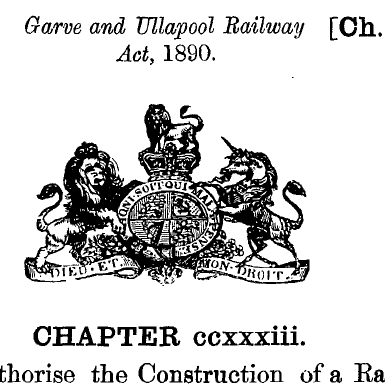 In August 1890, the promoters of the Garve to Ullapool railway arranged for a 'Local Act' to be passed in Parliament, which authorised them to go ahead, seek finance and build a railway.
In August 1890, the promoters of the Garve to Ullapool railway arranged for a 'Local Act' to be passed in Parliament, which authorised them to go ahead, seek finance and build a railway.
As we now know, this was when things started to go downhill quite swiftly.
The full text of the Act is reproduced here; it is a fairly dry document, but pages 6-7 and 9-11 are - unintentionally - amusing.
Sample pages from the Book of Reference for the Ullapool Railway
 Any formal plans for railways, submitted to Parliament for approval, had to be accompanied by a 'Book of Reference'. This was essentially a list of all the pieces of land, sections of road and stretches of water over which the proposed railway would run. The purposes and owners or lessees of such land were named.
Any formal plans for railways, submitted to Parliament for approval, had to be accompanied by a 'Book of Reference'. This was essentially a list of all the pieces of land, sections of road and stretches of water over which the proposed railway would run. The purposes and owners or lessees of such land were named.
These books of reference provide a fascinating picture of land-ownership.

The sample pages available here show (firstly) the land around Loch Droma and Braemore - mostly owned by Sir John Fowler; and (secondly) the land around Ardcharnish Leckmelm - partly owned by Alexander Pirie, wealthy mill-owner of Aberdeen.
These images supplied courtesy of the National Records of Scotland.
The 1893 Ullapool (Abandonment) Act (1893)
 In 1893, after the promoters failed to find finance to build the Garve to Ullapool Railway, an Act of Parliament was passed to 'abandon' it.
In 1893, after the promoters failed to find finance to build the Garve to Ullapool Railway, an Act of Parliament was passed to 'abandon' it.
Two pages of legal stuff, and then that's it: gone. There is really nothing else to say...
The Walpole report (1890)
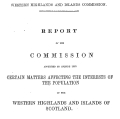 In the summer of 1890, a deputation led by Spencer Walpole set off to inquire into the conditions of transport and industry in the western Highlands and Islands. Their report was published later in the year, making various interesting suggestions, but not coming to any real decisions.
In the summer of 1890, a deputation led by Spencer Walpole set off to inquire into the conditions of transport and industry in the western Highlands and Islands. Their report was published later in the year, making various interesting suggestions, but not coming to any real decisions.
The Hon. Secretary of the Garve to Ullapool Railway, P. Campbell Ross, was moved to state that this report was 'drivel'...
The Hutchinson report (1892)
 In the summer of 1891, another commission of inquiry was sent out by the government, to try to focus on which railways should be built in north-west Scotland. This team based its inquiries on the report previously drawn up by Walpole. The new report was short - very short indeed - and was not published by the government until 1892.
In the summer of 1891, another commission of inquiry was sent out by the government, to try to focus on which railways should be built in north-west Scotland. This team based its inquiries on the report previously drawn up by Walpole. The new report was short - very short indeed - and was not published by the government until 1892.
Local people were outraged by this report, which claimed that Ullapool was a dangerous port for fishing-boats and steamers to approach, beset as it was by reefs and squalls. Mild-mannered Arthur Fowler even described it as ‘stupid, irritating and mischievous’.